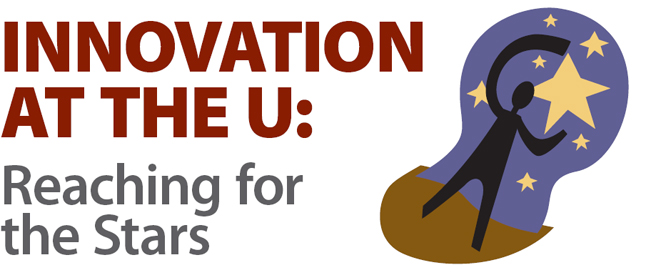

USTAR provides another tool for helping Utah’s best and brightest shine.
By John Blodgett
The University of Utah has established an impressive reputation in the life sciences and related research, which has spawned a number of flourishing companies, many located in Research Park adjacent to the U of U campus. But translating great ideas into a marketable product is far from simple. Often there is a gap in expertise between the people performing the research and the people best equipped to transform technology into viable commercial products.

Illustrations by Scott Greer
In an attempt to streamline that process, the Utah State Legislature passed a major initiative in 2006 that was put into effect that July. Senate Bill 75 created the Utah Science Technology and Research (USTAR) initiative, which provides funding to the University of Utah and Utah State University—the only two research universities in the state—to hire top-notch scientists with entrepreneurial experience to develop advanced research leading to product commercialization and the creation of high-technology jobs in Utah.
In short, the vision for USTAR is to build Utah’s economy upon the existing research strengths of the U and USU—including biomedicine, information technology, and imaging, among others. In addition, USTAR provides for the formation of commercialization teams across the state, under the banner of the Technology Outreach and Innovation Program (TOIP), to commercialize innovations in the regions that house Weber State University, Utah State University-Uintah Basin, Salt Lake Community College, Utah Valley University, and Southern Utah University.
“A lot of our success in commercialization is from the excellence of existing faculty,” says Jack Brittain, dean of the U’s David Eccles School of Business, vice president of Technology Venture Development (or “Tech Ventures”), and a member of the TOIP advisory council. However, he notes, “The USTAR faculty we have hired are not only entrepreneurs, but also inventors. They are idea generators.”
Faculty entrepreneurs are vital to USTAR’s success in encouraging innovation and creating high-paying jobs. The path to these high-paying jobs is lined with companies on the cutting edge of one life sciences field or another, and these companies historically emerge from the research of individuals who have the savvy to see not only a product that does not yet exist, but also how to bring it to market.
According to Fred C. Esplin MA’74 MS’74, vice president for Institutional Advancement at the U, USTAR is a very important component of the University’s recently launched comprehensive campaign, Together We Reach: The Campaign for the University of Utah. Of the campaign’s five major themes—Engaging Our Students, Elevating Our Research, Expanding Our Global Outlook, Enhancing Our Learning Environment, and Enriching Our Community—USTAR, says Esplin, fits into several. “USTAR facilities are one of the campaign’s top priorities, and we are looking for both public and private support to finance their construction,” he says. Specifically, the Health Sciences and main campuses will be connected by an interdisciplinary research corridor with the USTAR complex serving as anchor.
As executive director of USTAR, Ted McAleer is responsible for areas ranging from community outreach to research assessment to facilities construction. “I spend time understanding the strategic value of research teams so that when I interview potential faculty I understand how they will fit with USTAR and within the existing faculty,” he explains. “I also meet with members of the community to help them understand what USTAR means for Utah industry and why they should develop agreements with USTAR teams or other academic programs. [In turn], we try to understand the needs of Utah industry and make sure these strategic research areas will align with the state’s major industry clusters. Ideally, we’re helping to be a catalyst for Utah.”
To attract USTAR faculty, McAleer relies heavily upon selling the same benefits that many companies in Utah offer. “Quality of life is our secret weapon when we recruit,” he says. “We can’t outspend big-budget states, so we need to attract people who are attracted to what Utah offers and want to be a part of the teams we’ve already created.”
Marc Porter and Hamid Ghandehari are two of the U’s USTAR faculty. Their specialties overlap: Porter works in the nanotechnology and biosensors research cluster, Ghandehari in biomedical device innovation. Both research personalized medicine, among other areas, using nanotechnology to deliver drugs tailored to individual needs and to a specific cellular-level location. “Getting the stuff we do from the lab to the marketplace is a difficult task,” acknowledges Porter. “You have to get all the planets in alignment to make it happen. It’s hard work, and you’ve got to be lucky.”
According to Ghandehari, nanotech is any technology measuring roughly 1/1,000th the width of a human hair. “We use advances in nanotechnology for targeted drug delivery and eventually biotech devices,” he explains. “Utah is in a great position for the commercialization of drug delivery systems”—due, he adds, to the state’s critical mass of “outstanding” drug-delivery scientists and technology. Both Ghandehari and Porter are working to establish a nanotechnology institute on campus to strengthen the collaboration among nanotechnology, biology, and medicine efforts at the U.
The U is committing considerable funds and other of its resources to USTAR with the knowledge that the entire campus will benefit. “Our faculty understands that USTAR is a win for the whole University,” says Brittain. For example, the U is building laboratories that are properly equipped for what Brittain calls “translational” research, or the research necessary to test commercial potential. “Every faculty member benefits when we have a state-of-the-art lab put together,” he says. “Existing faculty are also getting access to these very well-equipped labs.”
McAleer was in the right place at the right time with the right experience when USTAR was getting off the ground. Brittain, in his role as vice president of Tech Ventures, hired McAleer in the summer of 2005 to focus solely on industry-sponsored research. According to McAleer, a week or so later Brittain was asked to help shape what ultimately would become USTAR. He brought McAleer on board to focus on the economic potential of the initiative. “When USTAR became law in February 2006, I was in a good position to understand what it was supposed to be,” says McAleer, who was named USTAR’s executive director later that year.
One of McAleer’s first major projects is to oversee the construction of the James LeVoy Sorenson Molecular Biotechnology Building, a $130 million facility that is part of the University’s comprehensive campaign and that will function as USTAR’s beating heart. “The building should be an industry magnet that attracts Utah, national, and international industry to come and collaborate with USTAR faculty on 21st-century problems,” he says. “It’s got to be an interdisciplinary collaboration, and it needs to encourage other members of the faculty who aren’t sponsored by USTAR to want to collaborate with them.”
In addition, McAleer hopes that when students familiarize themselves with the Utah companies housed in the building, they will be encouraged to remain in Utah to work after graduation. “Not every innovation out of USTAR will exist forever in Utah,” he acknowledges. “But, hopefully, [USTAR] will inspire students to want to work on these kinds of projects.”
USTAR hosts a full calendar of events created with both educational and social aspects in mind. Brittain says that one of the best attended events so far is “Tech Tuesday,” a six-times-per-year, invitation-only community networking opportunity. Demand for attendance is beyond the maximum capacity of 120 guests, who are usually inventors (most from the U faculty, according to Brittain) and investors, along with the occasional intellectual property attorney. As a result of these and other programs, investors are beginning to come on board to help commercialize technological innovations.
Suzanne Winters PhD’87, former science advisor to Gov. Michael Leavitt, is the director of the Salt Lake County TOIP. Its mission, she explains, is to help connect businesses with relevant technology resources at the U and USU. “The bottom line is high-wage job creation.”
Working from an office in the Salt Lake Community College Miller Innovation Center in Sandy, Winters says she collaborates mainly with life sciences companies—in the areas of drug discovery, pharmacology, and bio-devices—to help bring their inventions to market. The purpose of TOIP, she explains, is not to provide funding, but rather to connect inventors with investors based on the strength of an idea. “All inventors think what they need is money,” she says. “In most cases, that’s not their first need, from our perspective. Very few inventors have the ability to take an invention to the marketplace.”
TOIP first connects a fledgling company with a mentor who has both the entrepreneurial experience and the understanding of what it takes to commercialize an idea. Next, TOIP helps determine whether a large enough market exists for any particular innovation. If all signs point in that direction, Winters and her colleagues in other parts of the state will try to bring these companies to the attention of venture capitalists.
USTAR is still in its initial stage, yet enthusiasm and anticipation run high. Already, promising research is being performed under the initiative’s umbrella—Brittain is excited about inroads being made into the harnessing of waste heat, for example. Bolstered by existing U resources that have proven track records in commercializing innovation (see sidebar), USTAR is on the road to becoming a powerful economic engine for Utah as the state travels at full throttle into the 21st century.
—John Blodgett is a Salt Lake City-based freelance writer.
Return to Winter 2008 table of contents | Back to top |






